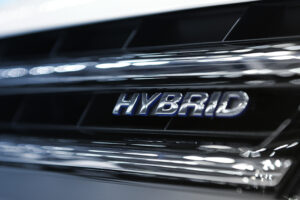
Edmunds: Hybrid vehicles outpacing EV demand
By onMarket Trends | Technology
Hybrid market share will continue to grow in the new year as automakers “reevaluate electrification strategies,” according to a new analysis.
In its 2024 Predictions report, Edmunds noted that as the transition to electric vehicles (EVs) has slowed, hybrids have become a more “comfortable choice” for U.S. drivers seeking internal combustion engine (ICE) alternatives.
Its data showed that in November, hybrid market share reached 9.7%, up from 4.9% in November 2022, representing 99% year-over-year growth. During the same period, EV market share increased by just 25%, it noted.
“Sales are taking off for the humble hybrid,” Ivan Drury, director of insights at Edmunds, told ABC News. “You’d be hard-pressed to find a hybrid — they’re almost all sold out. They’re vehicles for people who want to live their life with more benefit and less complexity.”
Overall, Edmunds said new auto sales are likely to remain relatively flat in 2023 with 15.7 million new vehicles sold representing a 1% year-over-year increase from the 15.5 vehicles sold last year.
EVs will likely represent 8% of total vehicle sales in 2024, up from 6.9% this year, it added.
“2023 experienced improved inventory levels from pandemic-era lows combined with pent-up demand to deliver strong sales estimated up 12.7% year over year,” said Jessica Caldwell, Edmunds’ head of insights. “While the year ahead holds the promise of further increased inventory and enticing deals that consumers have eagerly awaited, 2023’s high interest rates are expected to linger, provoking conflicting market dynamics.
“Automakers specifically will weigh one other key consideration in 2024: Are they satisfied with this newly established supply-demand equilibrium, or are they willing and able to push sales volumes closer to prepandemic norms?”
Hyundai Motor Group said Hyundai and Kia set a record by selling 767,000 hybrid vehicles through November, according to local media reports. The figure represented a 32% year-over-year increase.
Ford’s chief financial officer told Barclays 2023 Global Automotive & Mobility Tech attendees in December that hybrids could serve as a bridge to help companies meet regulatory requirements as EV demand cools.
“I think for us, we’ve been in the hybrid business for a long time,” John Lawler said, according to Ford Nation. “The number one selling hybrid pickup trucks in the US are F-150 and Maverick, and maybe we became a little bit complacent in how we spoke about hybrids because to us it was just part of our DNA and our business for Blue.”
Earlier this year, Ford CEO Jim Farley also spoke to the popularity of the OEM’s hybrid models, calling them “extremely popular.”
“Ten percent of all F-150s and 56% of all Mavericks sold in the U.S. are sold as hybrids,” Farley said. “We are adding hybrid options across our ICE lineup and we expect to quadruple our hybrid sales in the next five years. We were already No. 2 in the market last year. Starting Jan. 1, we moved to a new retail model for Model e, way ahead of our competition; again, a differentiated model that will deliver non-negotiated price, a simple shopping and ownership experience, and remote services for all of our customers.”
During Ford’s Q3 earnings call, Chief Financial Officer John Lawler said the company’s EV branch, Model 2, lost $1.3 billion during the quarter. Given the “challenging market” for Generation 1 productions, he said the OEM is postponing about $12 billion in EV-related spending. Cuts include some Mustang Mach-E production, delaying the second BlueOval SK JV battery plant in Kentucky, and evaluating the BlueOval Battery Park Michigan plant “to determine the best path forward.”
Toyota said in its November sales report that hybrid sales were up 51.6% year-over-year. Its battery EV sales were up 226%.
Images
Featured image courtesy of pictafolio/iStock
